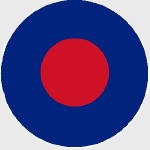Hobby Master HA2315 RAF Bristol Beaufighter Mk. IC Fighter - Squadron Leader AW Fletcher, No.272 Squadron, Luqa, Malta, 1941 (1:72 Scale)
"On, on!"
- Motto of No.272 Squadron
 Developed as a private venture by the Bristol Aeroplane Company, the Beaufighter was a two-seat all-metal fighter using components from the Beaufort torpedo-bomber. First flown on July 17th, 1939, the Beaufighter eventually equipped 52 RAF squadrons, giving outstanding service during World War II, in particular as a night-fighter and torpedo-bomber (where the aircraft were affectionatey known as 'Torbeaus').
Developed as a private venture by the Bristol Aeroplane Company, the Beaufighter was a two-seat all-metal fighter using components from the Beaufort torpedo-bomber. First flown on July 17th, 1939, the Beaufighter eventually equipped 52 RAF squadrons, giving outstanding service during World War II, in particular as a night-fighter and torpedo-bomber (where the aircraft were affectionatey known as 'Torbeaus').
Entry into Fighter Command service came during August 1940 with the Fighter Interception Unit at Tangmere. The following month, five squadrons received the Mark 1F equipped with Mark IV Air Intercept radar for night-fighter duties although the type's first kill wasn't until November of that year. The Beaufighter continued as a night-fighter until 1943, and the last aircraft (a TT10) was not retired from RAF service until 1960, nearly 21 years after the type's first flight.
1941 saw the development of the Beaufighter Mk.IC long-range heavy fighter. This new variant entered service in May 1941 with a detachment from No. 252 Squadron operating from Malta. The aircraft proved so effective in the Mediterranean against shipping, aircraft and ground targets that Coastal Command became the major user of the Beaufighter, replacing the obsolete Beaufort and Blenheim.
Coastal Command began to take delivery of the up-rated Mk.VIC in mid 1942. By the end of 1942, Mk VICs were being equipped with torpedo-carrying gear, enabling them to carry the British 18-inch or the US 22.5-inch torpedo externally. The first successful torpedo attacks by Beaufighters came in April 1943, with No. 254 Squadron sinking two merchant ships off Norway.
The Hercules Mk XVII, developing 1,735 hp at 500 feet was installed in the Mk VIC airframe to produce the TF Mk.X (Torpedo Fighter) - commonly known as the "Torbeau." The Mk X became the main production mark of the Beaufighter. The strike variant of the "Torbeau" was designated the Mk.XIC. Beaufighter TF Xs would make precision shipping attacks at wave-top height with torpedoes or rockets. Early models of the Mk Xs carried metric-wavelength ASV (air-to-surface vessel) radar with "herringbone" antennae carried on the nose and outer wings, but this was replaced in late 1943 by the centimetric AI Mark VIII radar housed in a "thimble-nose" radome, enabling all-weather and night time attacks.
The North Coates Strike Wing (Coastal Command), based at RAF North Coates on the Lincolnshire coast, developed attack tactics combining large formations of Beaufighters on anti-flak suppression with cannon and rockets while the Torbeaus attacked on low level. These tactics were put into practice in mid 1943 and in a 10 month period 27,000 tonnes of shipping were sunk. Tactics were further adapted when shipping was moved from port during night hours. North Coates Strike Wing operated as the largest anti-shipping force of the Second World War, and accounted for over 150,000 tons of shipping and 117 vessels for a loss of 120 Beaufighters and 241 aircrew killed or missing. This was half the total tonnage sunk by all strike wings between 1942-45.
Pictured here is a 1:72 scale RAF Bristol Beaufighter Mk. IC fighter that was attached to No.272 Squadron, then deployed to Malta, during 1941.
Sold Out!
Dimensions:
Wingspan: 9-3/4-inches
Length: 7-inches
Release Date: December 2015
Historical Account: "Operation Herkules" - Operation Herkules was the German code-name given to a planned but never-executed Italo-German invasion of Malta during World War II (the Italian code-name was Operazione C3). Through combined air and sea landings, the Axis powers hoped to eliminate Malta as a British air and naval base and secure an uninterrupted flow of supplies across the Mediterranean Sea to their forces fighting in Libya and Egypt. Though extensive preparations were made by both German and Italian military forces, the rapidly changing war situation in North Africa resulted in the plan's cancellation in July 1942.
The Axis plan to invade Malta had its origin in Italian military studies conducted in the mid-1930s during Italy's conquest of Ethiopia. By 1938, the Italian army command had estimated the amount of sea transport it would require to move significant military forces into North Africa and identified the seizure of Malta as a necessary prerequisite. An outline plan for a seaborne assault was drawn up and periodically updated but the Regia Marina (Italian Navy) initially showed little interest in it.
The concept was approved at a meeting between Adolf Hitler and Benito Mussolini on April 29th-30th, 1942.


